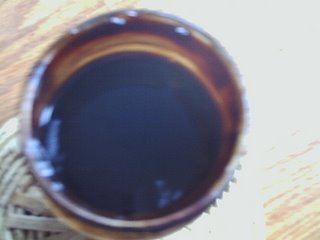
Last weekend the boyfriend and I went to Chicago, ostensibly to hang around downtown and Navy Pier. What I really wanted to do was to check out the ethnic grocery stores on Devon Avenue. I got a quick glimpse of Devon a couple of years ago when I was in Chicago with my parents and they had taken a wrong turn while looking for the freeway entrance. The street was teeming with ethnic groceries--Russian, Indian, Turkish--and I've been intrigued ever since.
When you first turn onto Devon, Russian-Jewish businesses abound. I spotted a Jewish community center, an Israeli restaurant and Russian grocery stores, bookstores and video stores. Several blocks later, stores with names like Tbilisi and Balalaika give way to blocks and blocks of Indian and Pakistani businesses, with the occasional Chinese restaurant thrown in.
When you first turn onto Devon, Russian-Jewish businesses abound. I spotted a Jewish community center, an Israeli restaurant and Russian grocery stores, bookstores and video stores. Several blocks later, stores with names like Tbilisi and Balalaika give way to blocks and blocks of Indian and Pakistani businesses, with the occasional Chinese restaurant thrown in.

I did a quick Google search the night before our trip and unearthed Argo, a Georgian cafe/bakery/grocery where we stopped for lunch. A small fence separates the tiny two-table cafe from the actual bakery, where two employees were busy rolling out dough when we came in. I asked the friendly owner if they had hachepuri, Georgian cheese bread, and, of course, they did. We were served hot, flaky puff pastry stuffed with feta cheese on paper plates. Then we sampled meat, potato and sauerkraut pirozhki, all made with the same flaky dough. The potato pastry was the best of those three, but hachepuri was my favorite.
We took home a pound of pelmeni--Argo sells all sorts of frozen doughy goodies--two more hachepuris and five loaves of bread, still warm from the oven. One of the breads was a long, baguette-like loaf and the other four were lavash. Lavash, a round, puffy bread that looks like a baked pizza shell, was fantastic. I wish I had taken a picture of it but we ate one loaf in the car on the way home, another loaf after we got home, and the rest we gave to our respective parents.
Argo also sells Georgian and Russian specialties like sour plum sauce, adjika (a spicy relish), suluguni cheese (used as filling in hachepuri), kefir, sour cream, caviar, etc. (See this for another review of Argo, plus pictures. I think the owner is in the first photo.)
After lunch we walked down Devon, past the Indian restaurants and the women in saris, past the mosques and Pakistani groceries smelling of exotic spices and the video stores displaying posters of Bollywood hotties. We were too full to eat anything else. I'd love to come back and explore this part of the street, and I'm especially intrigued by the very reasonably priced lamb and mangos in the ethnic groceries.
We took home a pound of pelmeni--Argo sells all sorts of frozen doughy goodies--two more hachepuris and five loaves of bread, still warm from the oven. One of the breads was a long, baguette-like loaf and the other four were lavash. Lavash, a round, puffy bread that looks like a baked pizza shell, was fantastic. I wish I had taken a picture of it but we ate one loaf in the car on the way home, another loaf after we got home, and the rest we gave to our respective parents.

Argo also sells Georgian and Russian specialties like sour plum sauce, adjika (a spicy relish), suluguni cheese (used as filling in hachepuri), kefir, sour cream, caviar, etc. (See this for another review of Argo, plus pictures. I think the owner is in the first photo.)
After lunch we walked down Devon, past the Indian restaurants and the women in saris, past the mosques and Pakistani groceries smelling of exotic spices and the video stores displaying posters of Bollywood hotties. We were too full to eat anything else. I'd love to come back and explore this part of the street, and I'm especially intrigued by the very reasonably priced lamb and mangos in the ethnic groceries.
* Argo Georgian Bakery
2812 W. Devon Ave.
Chicago, IL 60659-1502
(773) 764-6322
2812 W. Devon Ave.
Chicago, IL 60659-1502
(773) 764-6322













